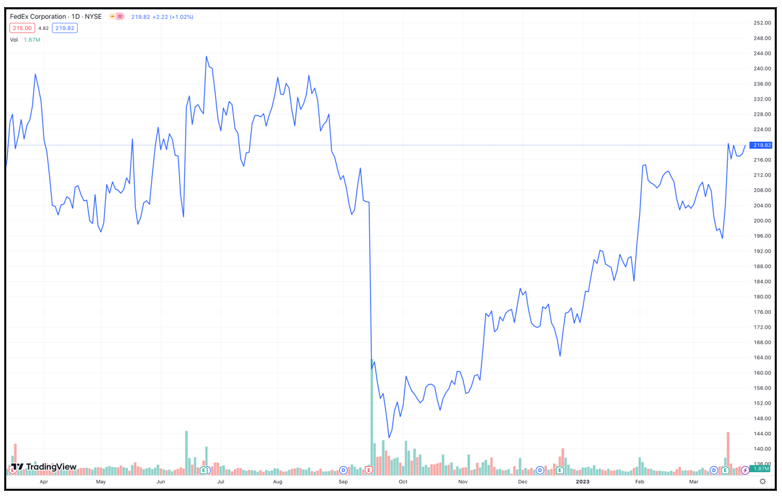As Storefronts Disappear, This Company Is a ‘Buy’
 |
| By Jon Markman |
COVID-19 and e-commerce changed retail.
Now industry executives are taking a hard look at the need for physical stores, and it is a big opportunity for investors.
It’s all about something the industry calls customer acquisition costs, according to research last week from Benedict Evans, a noted technology analyst. Store rents are another interchangeable ingredient in the CAC stew.
To take advantage of this new wrinkle in retail, investors should consider buying FedEx (FDX). Let me explain.
Years ago, the blueprint for growing sales was simple: Build storefronts.
Even with the emergence of e-commerce in the early 2000s, retail executives believed brick-and-mortar stores were vital to the customer experience. When Amazon.com (AMZN) started opening stores in 2015, this view seemed to be validated. The convenience of digital shopping carts was trumped by the satisfaction of the real thing, according to a Forbes contributor.
Amazon is now rethinking its physical store strategy. The online giant will close eight of its cashier-less Amazon Go convenience stores and plans to shutter all 68 of its bookstores.
Industry executives have moved on from the strategy of opening stores to grow sales.
Storefront rents used to be a separate category for retail chief financial officers. Now rent is being bundled in the same broad CAC category as product placement marketing, digital search advertising, brand marketing, lower prices, better return policies and free shipping.
Amazon.com built a $38 billion per year advertising business by auctioning search words on its digital storefront. Retailers pay a fee to have their products placed first on the list.
This is the online version of the business model used by grocery stores to sell eye-level shelf space to brands like Proctor & Gamble (PG) and Colgate-Palmolive (CL). However …
Marketing Is Only
1 Piece of the Puzzle
Evans points out that executives are asking harder questions about how customers physically get goods and what is the best return on capital when there is an infinite supply of products and media.
Apple (AAPL) operates a wonderful retail store chain, yet it only generates 10% of annual sales. The stores are not so much about retailing as they are a marketing tool, according to Evans. Bright, crowded Apple stores exist to showcase the greatness of iPhones, iPads and Mac computers.
On the other end of the spectrum, Shein — a Chinese fashion retailer — is breaking all the rules of product development and winning.
The Wall Street Journal reported last April that the fast-growing Chinese brand was valued at $100 billion, more than the combined market capitalizations of H&M and Zara, the two largest fast-fashion store chains. Shein’s secret?
Infinite Supply & Unlimited
Media Marketing
The online-only firm generates 5,000–10,000 new consumer products every day. Designs are premarketed throughout social and other online channels. Only those orders are manufactured and shipped.
This model is a game changer.
Retailers are learning they can earn outsized returns on investment by bypassing expensive retail space leases and employee costs in favor of a direct-to-consumer business model. The kicker is built-in lower pricing, better return policies and free shipping.
FedEx is a global logistics behemoth, operating in 220 countries and territories. This firm is the logical gatekeeper to the coming D2C bonanza.

Click here to view full-sized image.
Global e-commerce is expected to grow from $3.3 trillion in 2022 to $5.4 trillion in 2026, according to a report from researchers at Morgan Stanley (MS).
Executives at FedEx have been rightsizing the business following the extraordinary jump in deliveries during the pandemic. The business simply grew too quickly. Those excesses are now being corrected.
In March, CEO Raj Subramaniam said Q3 earnings reached $3.41 per share, 25% above the prior forecast. Subramaniam credited cost cutting and improved efficiency for the results. He also announced that FedEx now anticipates full-year earnings per share should reach the range of $13.80–$14.40.

Click here to view full-sized image.
At a price of $219.82, FedEx shares trade at 18.7x forward earnings and only 0.6x sales. These metrics are within the historic multiples and do not reflect the coming D2C boom.
Shares should trade back to $305 within 18 months: a gain of 38.6% from current levels.
Remember to always conduct your own due diligence before entering a trade.
Thanks for reading,
Jon D. Markman
P.S. According to Weiss Analyst Chris Graebe, the Silicon Valley Bank panic is already driving promising companies to equity crowdfunding, an alternative funding that allows regular, nonaccredited investors to invest in early, pre-IPO companies. This presents a huge opportunity for Weiss Members. Yesterday, Chris unveiled one such opportunity that is well-positioned to disrupt a $100 billion industry. Click here to learn more about how to claim an early stake.

